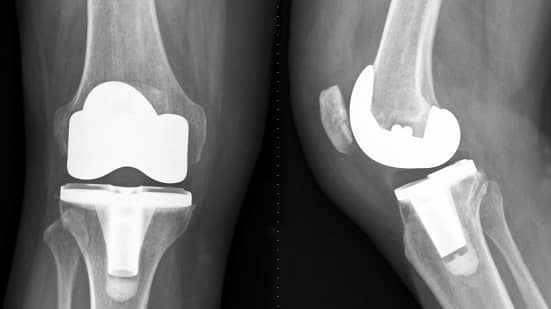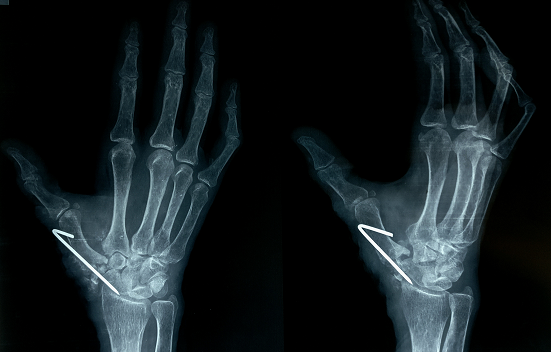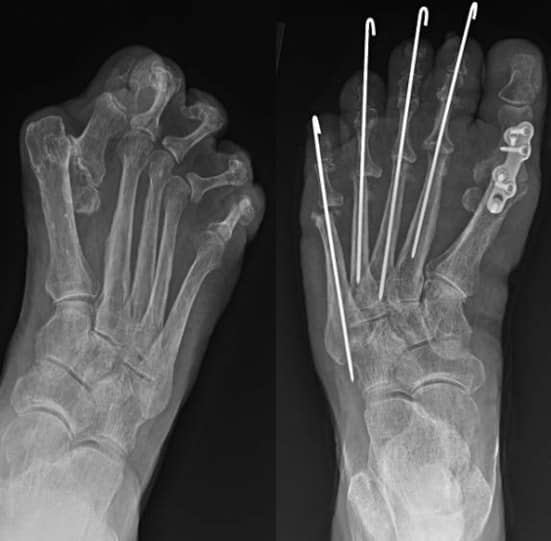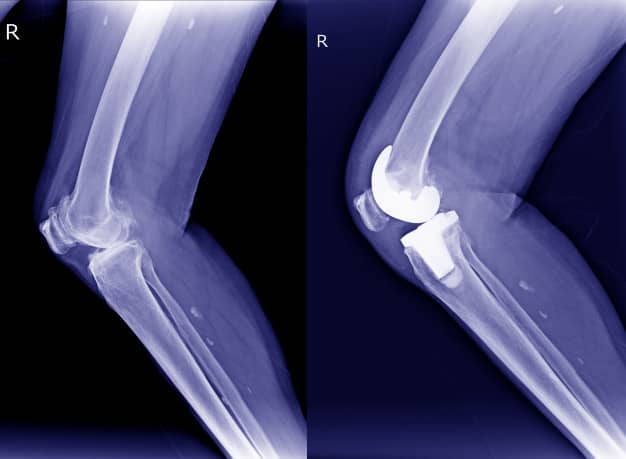Arthroplasty is a surgical procedure performed by an orthopedic surgeon that alters or completely replaces a joint in the body. The purpose of this surgery is to restore normal motion and relieve pain in a distorted or diseased joint, such as the Hip, Knee, Shoulder, Elbow, or Ankle.
It is usually performed when other medical treatments have not improved the function in the affected joint, and pain still continues. Depending on the severity of the problem with the joint and other factors, there are three main Arthroplasty Types: Joint Replacement Surgery, Joint Resection, or Excision Arthroplasty, and Inter-Positional Reconstruction.
Now, let’s discuss each Arthroplasty Types in-short to know the difference between each one of them…….
Arthroplasty Types
As mentioned above Arthroplasty are of mainly three types, that include:
Joint Replacement

For the last 45 years, the most successful and common arthroplasty type is the surgical replacement of arthritic or destructive or necrotic joint or joint surface with a prosthesis. For example, a knee joint that is affected by osteoarthritis may be replaced entirely (Total Arthroplasty Knee) with a prosthetic knee.
The purpose of this procedure is to relieve pain, restore range of motion, and to improve walking ability, thus leading to the improvement of muscle strength.
Joint Resection or Excision Arthroplasty

This arthroplasty types involve removing a portion of the bone from a stiffened joint and increasing the space between the bone and the socket to improve the range of motion. The remaining ends of the bones are left to give time for scar tissue to fill in the gap.
Scar tissue eventually fills the gap, narrowing joint space again. Pain is relieved and motion is restored after Joint Resection, but the joint is less stable.
Inter-Positional Reconstruction

This type was previously a popular form of arthroplasty, with interposition of some other tissue like skin, muscle, or tendon to keep inflammatory surfaces apart. This involves surgery to reshape the joint and to add a prosthetic disk between the two bones forming the joint.
This prosthesis is made of plastic, metal, ceramic material, or formed from such body tissue as skin, muscle, or fascia. When Inter-Positional Reconstruction fails, total joint replacement may be necessary.
Arthroplasty Indications
Arthroplasty Indications include significant disabling pain, deformity, and reduction in the quality of life. Generally, patients at this stage of discomfort and disability will most likely have already been diagnosed with a form of arthritis.
Pain and stiffness on weight-bearing joints are the major symptoms that patients report, though some people experience night pain as well. Other symptoms may include stiffness, swelling, and locking of the joint; and even the joint giving way, particularly when the knees or hips are affected.
So, to determine the extent of disabling, the referring physician and/or the surgeon will likely ask you about walking distance, sporting ability, the need for walking aids, and the ability to perform self-care tasks such as dressing and bathing.
Who Might Needs an Arthroplasty?
Arthroplasty may be required due to cartilage wears out, limb/joint malalignment, joint space narrowing, a stiff joint, disease, or other degenerative or traumatic conditions.
However, when other medical treatments are no longer helpful to relieve joint pain and disability, then doctors recommend this surgery.
Here are some treatments for osteoarthritis that may be used before arthroplasty include:
- Anti-inflammatory medicines
- Pain medicines
- Limiting painful activities
- Assistive devices for walking, such as a cane
- Physical therapy
- Cortisone injections into a knee joint
- Visco-supplementation injections, to add lubrication into the joint to make joint movement less painful
- Loss of excess weight
- Exercise and conditioning
People who under-go arthroplasty usually have a lot of relief from their joint pain. Post-Arthroplasty they are able to do daily activities with more ease and have a better quality of life.
Possible Risks and Complication of Arthroplasty
Arthroplasty carries the same risks as any other major surgeries, including risk for infections and blood clots. However, people who have heart problems, diabetes, and weak immune systems, are at high risk for those complications.
Other risks of this surgery include:
- Bleeding
- Infection and Blood clots in the legs or lungs
- Loosening of prosthetic parts
- Stiffness or pain that does not go away
Nerve or blood vessel injury, which is very rare, can occur if the nerves surrounding the replaced joint become damaged during surgery. This results in weakness or numbness. You may get relief from the joint pain by the surgery. Or full function of the joint may not return, just after the surgery.
There may be other risks depending on your overall health. So first talk about any concerns with your healthcare provider before the procedure.
How to Prepare Yourself for Arthroplasty?
Arthroplasty is major surgery and recovery will generally take a month or more. You will also be in pain during recovery, so it is a good idea to prepare yourself for what is to come.
Make the Time Commitment
In general, you will be up and moving the first day after the procedure—however, recovery will still take time. Plan on taking the necessary time off from work and make sure you have help with responsibilities, including caring for children or pets.
Schedule Physical Therapy
Frequent physical therapy is part of your rehabilitation. If this is the case, make plans for where you will be undergoing therapy and how will you get there—you will not be able to drive during recovery from arthroplasty.
Order Assistive Devices
Work with your medical team to determine what medical equipment you will need once you get home after surgery. This may include devices such as a cane or walker, a chair for support in the bathtub, or grab bars for the toilet.
Rearrange Your Home
If everything in your home is not accessible to you with limited movement, you will need to reorganize things accordingly, so that everything is on one floor and within reach. This is especially important during the first few weeks post-surgery.
So, make sure that you are able to easily access everything you’ll need in your home without the potential to strain your surgery site.
Address All Medical Issues
If you have other medical concerns, such as heart problems or diabetes, make sure to consult that with your surgeon. Recovery from surgery will take significant time.
Also, if you have any prior medical appointments, such as a toothache, make sure to address these prior to surgery. So that recovery from this procedure will be your main priority when the time comes.
Procedure: What Happens During an Arthroplasty Surgery
Arthroplasty procedure may be done when a person is asleep under General Anaesthesia or is awake under Regional Anaesthesia. This is something that doctors will decide on the extent of the surgery and your doctor’s practices and specific recommendations.
Next, you will be positioned on the operating table, that allows access to the joint to be operated on. Anesthesia is started through the IV line and the anaesthesiologists will monitor your heart rate, blood pressure, blood oxygen, and breathing throughout the surgery.
The surgeon will first clean the skin over the surgical site. The doctor will then make an incision around 8-12 inches in the surgical area. Then he/she will repair and/or replace the damaged part of the joint. Surgery can take up to two hours.

For example, Arthroplasty Knee involves taking out the damaged part of the knee and the surfaces of the thigh bone and shin bone next to the affected joint. The surgeon then implants the artificial knee joint prosthesis.
During arthroscopy, the prosthesis is made up of three parts:
- Tibial component (bottom part) to replace the top of the lower bone (tibia)
- Femoral component (top part), which replaces the femur (upper bone where the patella fits),
- Patellar part (knee cap) to replace the surface of the patella.
The femoral part is of metal and the tibial part includes a metal tray and a plastic spacer. The patellar part is of plastic, but can also be both plastic and metal.
If the surgeon performs a minimally invasive procedure, a smaller incision is made, which means less damage to muscles and tendons. Once the joint is repaired, removed, and/or replaced, the incision is closed with surgical staples or stitches. Lastly, the surgeon performs dressing and apply the bandage.
Moreover, similar is the process of Arthroplasty Hip Surgery. The only difference is Arthroplasty Hip Surgery, damaged hip joints get removed. However, to Know about the detailed process of Arthroplasty Hip, you can refer to some Hip Arthroplasty PPT.
Post-Surgery Recovery
After the surgery, you will be observed for several hours in the recovery room. Once blood pressure, pulse, and breathing are stable, the caretaker will take you to the hospital room where you will stay for a few days.
It is important to begin moving the new joint after surgery. A physical therapist will meet with you soon after the surgery. He/she will plan an exercise rehabilitation program for you. Your pain may reduce with medicine so that you can take part in the exercise program. Doctors may also give you an exercise plan to follow both in the hospital and after discharge.
You will go home or to a rehab center. In either case, your healthcare provider will arrange for ongoing physical therapy until you regain muscle strength and a good range of motion.
Recovery at Home
Once you are at home, it will be important for you to keep the surgical area clean and dry. Your healthcare provider will give you some bathing instructions. During a follow-up office visit, the doctors then remove the stitches or surgical staples.
Take a pain reliever for pain as advised by your healthcare provider. Aspirin or some other pain medicines may increase the chance of bleeding. So, make sure to take only approved medicines.
Tell your healthcare provider if you have any of these:
- Fever or chills
- Redness, swelling, bleeding, or other fluid leaking from the incision site
- Pain around the incision site that gets worse
- Numbness or tingling of the affected area
You may go back to your normal diet unless your healthcare provider tells you not to. Also, make sure not to drive until your healthcare provider tells you to.
As we have almost covered everything about Arthroplasty Surgery: Arthroplasty Indications, complications, and recovery, there is one query that every patient asks. And that is what is the difference between Arthroplasty Vs Arthroscopy and Arthroplasty Vs Replacement.
So, let’s gain some insights about these terms in order to avoid your confusion……………
Arthroplasty Vs Arthroscopy
Arthroplasty is an operative procedure in which the arthritic or damaged surfaces of the bone are removed and replaced with something better, called a prosthesis.
The goal of Arthroplasty Surgery is to reduce your pain and restore the function of a joint through resurfacing, realigning, or replacing the joint itself with man-made, long-lasting materials.

Pros for Arthroplasty
- A permanent solution to joint pain and osteoarthritis.
- The high success rate for eliminating joint pain. Surgical techniques and prosthetic implants are better than ever.
- a short 1-2-day hospital stay (shorter than ever).
Cons for Arthroplasty
- A lengthy recovery (6+ weeks without driving or being able to return to “normal life”
- A tougher rehabilitation
- More costly
Arthroscopy is the procedure in which the examination and treatment of the damage of the interior part of a joint are performed using an arthroscope. An arthroscope is a type of camera that is inserted into the joint through a small incision and allows the surgeon a view of the joint area on a video monitor.

A second incision is made for the insertion of small surgical instruments. This second incision is for both diagnoses and to perform what is necessary during the operation—removing tissue, suturing, and other repairs.
Pros for Arthroscopy
- Offers your surgeon a better view to properly diagnosis your hip or knee issue (better than an X-Ray).
- Viable treatment option for cartilage or meniscus damage.
- Can buy extra time before the more invasive arthroplasty.
- Smaller incision than arthroplasty.
- Faster healing and shorter recovery than arthroplasty.
- Less scarring for incision site.
- A less expensive procedure.
- Same-day surgery.
Cons for Arthroscopy
- Surgery with a long recovery period.
- Not used for arthritis. It won’t help the pain associated with osteoarthritis.
- Rehab along with a physical therapist is necessary to regain full movement.
- If joint pain and arthritis are severe, it may not be as effective as arthroplasty.
- Risk of infection.
So, this was the about Arthroplasty Vs Arthroscopy, now let’s move to Arthroplasty Vs Replacement………
Arthroplasty Vs Replacement
The truth is that there’s No Difference between arthroplasty and joint replacement; they’re the same procedure. Joint replacement therapy is one of the most advanced and most successful surgeries performed in the medical industry.
However, the term joint replacement can seem scary, which is why more and more doctors are using the term arthroplasty instead. Not only the term, but the process of Arthroplasty is also complex. That’s why it is important for the patient to select a right Orthopaedic Surgeon before planning for the surgery. And for this Dr. Ramakant Kumar, is the best choice for you. To know why to continue with the next section………
About Dr. Ramakant Kumar:
Ranked amongst the Top 5 Orthopedic Doctor in Patna, Dr. Ramakant Kumar is one of the Best Arthroplasty Surgery Doctor in Patna.
He is a committed high-profile surgeon of international reckoning with several publications of PUBMED repute. He had the privilege of acquiring the requisite acumen and skills in orthopedic surgery from the prestigious ALL INDIA INSTITUTE OF MEDICAL SCIENCES (AIIMS), New Delhi.
Ever since he has made rapid strides in the field of Orthopaedics with a primary focus on hip & knee surgery. Moreover, he has also done international fellowships in minimally invasive joint replacement surgery and Knee Arthroscopy from centers of international repute in Seoul, South Korea, and National University Hospital, Singapore.
His Advanced Bone & Joint Clinic is the premier orthopedic clinic in Patna focuses on delivering the highest quality care to people with chronic conditions. There he has successfully performed numerous cases of Hip & Knee Arthroplasty including revision surgeries.
So, if you residing near the Boring Road, Patna, and in search of an Arthroplasty Doctor in Patna, then contact him.
The Bottom Line
Both, Arthroplasty Knee and Hip Arthroplasty can drastically improve your quality of life and help you to enjoy the activities you previously enjoyed, including walking, biking, running, swimming, and so much more. Arthroplasty surgery is generally safe — millions of people get this surgery yearly and very few people experience complications.
Regardless, it is still a good idea to consult your doctor first about all the risks and benefits associated with Arthroplasty Surgery and how they apply to your unique situation. You must consider the time commitment for your recovery and rehabilitation.

